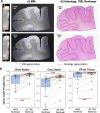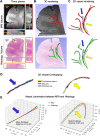This is a preprint.
Precise MRI-Histology Coregistration of Paraffin-Embedded Tissue with Blockface Imaging
- PMID: 40501733
- PMCID: PMC12157374
- DOI: 10.1101/2025.06.02.657335
Precise MRI-Histology Coregistration of Paraffin-Embedded Tissue with Blockface Imaging
Update in
-
Precise MRI-histology coregistration of paraffin-embedded tissue with blockface imaging.Imaging Neurosci (Camb). 2025 Aug 8;3:IMAG.a.106. doi: 10.1162/IMAG.a.106. eCollection 2025. Imaging Neurosci (Camb). 2025. PMID: 40800888 Free PMC article.
Abstract
Magnetic resonance imaging (MRI) provides 3D spatial information on tissue, yet it lacks at the molecular level. In contrast, histology provides cellular and molecular information, but it lacks the 3D spatial context and direct in vivo translation. Coregistering the two is key for the 3D-embedding of histological details, validating pathological MRI findings, and finding quantitative imaging biomarkers of neurodegenerative diseases. However, coregistration is challenging due to non-linear distortions of the tissue from histological processing and sectioning leading to microscopic and macroscopic nonlinear 3D deformations between specimen MRI and stained histology sections. To address this, we developed a novel pipeline, named Brewster's Blockface Quantification (BBQ), integrating robust optical approaches with innovative 2D and 3D registration algorithms to achieve precise volumetric alignment of specimen MRI data with histological images. On a variety of brain tissue specimens from distinct anatomical regions and across multiple species, our methodology generated blockface volumes with minimal distortion and artifacts. Using these blockface volumes as an intermediary, we achieve a precise alignment between MRI and histology slides, yielding registration results with an overlapping Dice score of ~90% for whole tissue alignment between MRI and blockface volumes, and >95% for 2D MRI-histology registration. This correlative MRI-histology pipeline with robust 2D and 3D coregistration methods promises to enhance our understanding of neurodegenerative diseases and aid the development of MRI-based disease biomarkers.
Keywords: Biomarkers; Blockface imaging; Coregistration; Neurodegenerative disease; Ultra-high-resolution MRI; Volumetric histology.
Figures












Similar articles
-
Precise MRI-histology coregistration of paraffin-embedded tissue with blockface imaging.Imaging Neurosci (Camb). 2025 Aug 8;3:IMAG.a.106. doi: 10.1162/IMAG.a.106. eCollection 2025. Imaging Neurosci (Camb). 2025. PMID: 40800888 Free PMC article.
-
Prescription of Controlled Substances: Benefits and Risks.2025 Jul 6. In: StatPearls [Internet]. Treasure Island (FL): StatPearls Publishing; 2025 Jan–. 2025 Jul 6. In: StatPearls [Internet]. Treasure Island (FL): StatPearls Publishing; 2025 Jan–. PMID: 30726003 Free Books & Documents.
-
An open-source deep learning framework for respiratory motion monitoring and volumetric imaging during radiation therapy.Med Phys. 2025 Jul;52(7):e18015. doi: 10.1002/mp.18015. Med Phys. 2025. PMID: 40665474 Free PMC article.
-
Magnetic resonance perfusion for differentiating low-grade from high-grade gliomas at first presentation.Cochrane Database Syst Rev. 2018 Jan 22;1(1):CD011551. doi: 10.1002/14651858.CD011551.pub2. Cochrane Database Syst Rev. 2018. PMID: 29357120 Free PMC article.
-
Intraoperative frozen section analysis for the diagnosis of early stage ovarian cancer in suspicious pelvic masses.Cochrane Database Syst Rev. 2016 Mar 1;3(3):CD010360. doi: 10.1002/14651858.CD010360.pub2. Cochrane Database Syst Rev. 2016. PMID: 26930463 Free PMC article.
References
-
- Alkemade A., Bazin P.-L., Balesar R., Pine K., Kirilina E., Möller H. E., Trampel R., Kros J. M., Keuken M. C., Bleys R. L. A. W., Swaab D. F., Herrler A., Weiskopf N., & Forstmann B. U. (2022). A unified 3D map of microscopic architecture and MRI of the human brain. Science Advances. 10.1126/sciadv.abj7892 - DOI - PMC - PubMed
-
- Amunts K., Kedo O., Kindler M., Pieperhoff P., Mohlberg H., Shah N. J., Habel U., Schneider F., & Zilles K. (2005). Cytoarchitectonic mapping of the human amygdala, hippocampal region and entorhinal cortex: Intersubject variability and probability maps. Anatomy and Embryology, 210(5), 343–352. 10.1007/s00429-005-0025-5 - DOI - PubMed
-
- Avants B., Tustison N. J., & Song G. (2009). Advanced Normalization Tools: V1.0. The Insight Journal. 10.54294/uvnhin - DOI
Publication types
Grants and funding
LinkOut - more resources
Full Text Sources
